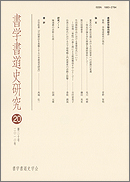2010 巻, 20 号
選択された号の論文の9件中1~9を表示しています
- |<
- <
- 1
- >
- >|
最新研究動向紹介
-
2010 年 2010 巻 20 号 p. 3-10
発行日: 2010年
公開日: 2012/03/28
PDF形式でダウンロード (10404K)
論文
-
2010 年 2010 巻 20 号 p. 11-25
発行日: 2010年
公開日: 2012/03/28
PDF形式でダウンロード (20826K) -
2010 年 2010 巻 20 号 p. 27-39
発行日: 2010年
公開日: 2012/03/28
PDF形式でダウンロード (17247K) -
2010 年 2010 巻 20 号 p. 41-56
発行日: 2010年
公開日: 2012/03/28
PDF形式でダウンロード (20781K) -
2010 年 2010 巻 20 号 p. 57-79
発行日: 2010年
公開日: 2012/03/28
PDF形式でダウンロード (29643K)
研究ノート
-
2010 年 2010 巻 20 号 p. 81-93
発行日: 2010年
公開日: 2012/03/28
PDF形式でダウンロード (16328K)
書評
-
2010 年 2010 巻 20 号 p. 94
発行日: 2010年
公開日: 2012/03/28
PDF形式でダウンロード (1139K)
お詫びと訂正
-
2010 年 2010 巻 20 号 p. e1
発行日: 2010年
公開日: 2012/03/28
PDF形式でダウンロード (329K) -
2010 年 2010 巻 20 号 p. e2
発行日: 2010年
公開日: 2012/10/12
PDF形式でダウンロード (329K)
- |<
- <
- 1
- >
- >|
